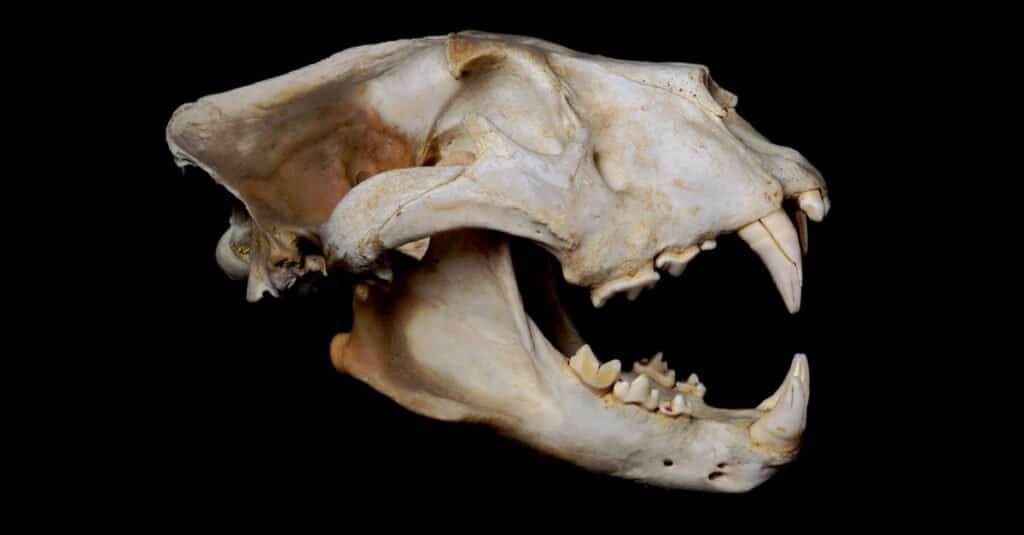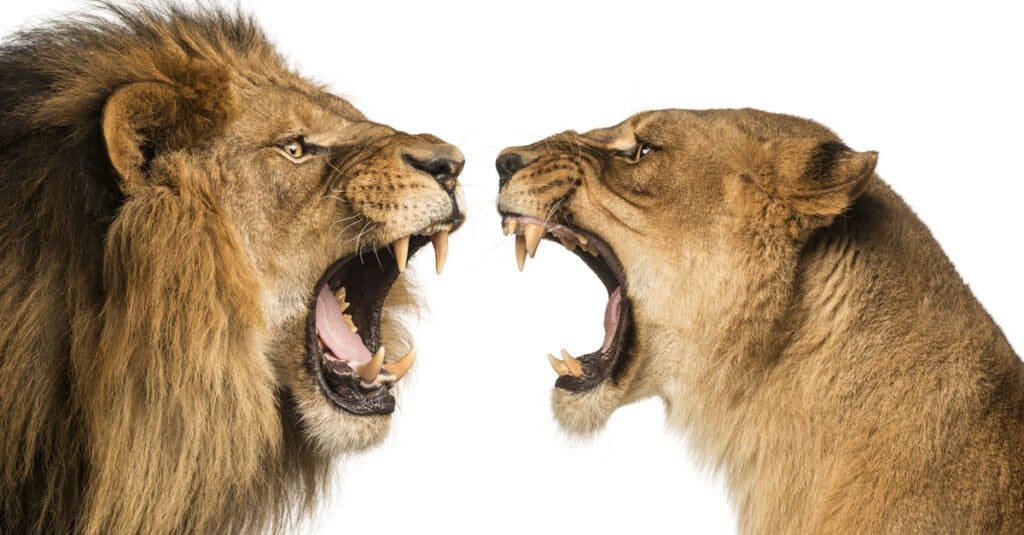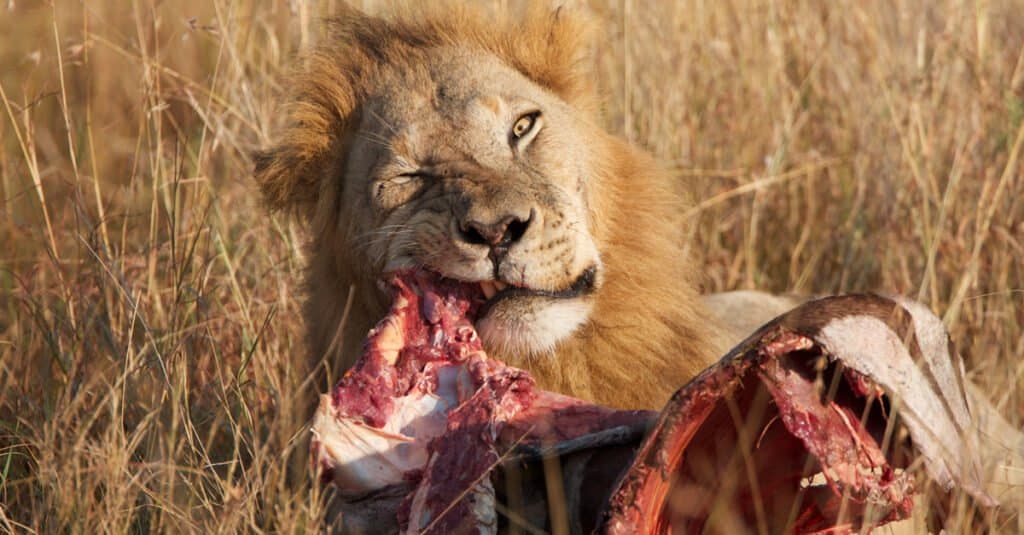Lions (Panthera leo) are recognizable all over the world. Their thundering roars fill us with images of circus performers and prides of feline hunters roaming the plains of Africa. Once endemic to many parts of Europe, India, the Caucasus, and Africa; lions are now limited to fragmented sanctuaries across Africa and one part of India. Because of habitat loss and poaching, they are listed as vulnerable to extinction, and are regionally extinct in many places.
Here, we’ll learn just what makes a lion’s teeth unique, how many sets they get in a lifetime, and what they use them for. Then, we’ll dive a little deeper into the special uses of each of their four tooth types, and learn just how hard a lion’s bite really is. Finally, we’ll explore why poachers might want to hunt lions for their teeth, and what you can do to help in the conservation of these awe inspiring cats.
Milk teeth
Lion cubs start their lives drinking exclusively mother’s milk. When they’re about three months old, they start eating small bits of meat. By this time they have all of their deciduous (milk) teeth, and can effectively chew tender bits. At around three months old they begin getting their permanent teeth. By the time they’re 15 months old, they have no baby teeth left, only the adult dentition they will carry for the rest of their lives.
Lions have a lifespan of up to 15 years in the wild. If they make it to this advanced age, their teeth are often so worn down that they must rely on other members of their pride for food. But, lions are social animals, and as long as there is enough food for the pride, old lions can still gum their meat and get by.
Adult teeth

Lions have 30 teeth; 12 incisors, 4 canines, and 14 carnassials.
©Audrey Snider-Bell/Shutterstock.com
Lions are obligate, generalist carnivores who occupy both the apex and keystone predator niches of their environment. This means that they hunt and eat meat, a lot of it. Lions are the most diurnal (active in the daytime) of the big cats, and will also eat carrion if they come across it. Since they need their teeth both to hunt, and to eat, they have a few different kinds to do the job.
Lions have a total of 30 teeth; 12 incisors, four canines, ten premolars, and four molars.
Incisors
Lions have 12 incisors; six on the top, and six on the bottom. In the upper jaw, the corner incisors closest to the canines are bigger than the central and lateral incisors, and there is a gap between them and the canines. Lions use these teeth to grab and pull food, and to scrape meat from bones. They also use them for grooming themselves and other members of their pride.
Canines
Lions have four massive canine teeth. They use these teeth to grab and hold onto fleeing prey. The canines can grow up to seven centimeters long, and are conical and slightly recurved back towards the skull. They’re not sharp like a house cat’s canines; instead, they’re blunted, and used to clamp onto the nose or windpipe of prey. Lions kill by strangulation or suffocation, and their canine teeth are instrumental in this process.
Carnassials
The premolars and molars of the lion perform the same function; cutting meat. They are known as carnassials; they have high, sharp crowns that occlude against each other on the top and bottom like a pair of scissors. These shearing teeth, coupled with the lion’s ability to open its hinged jaw nearly a foot wide, liken its mouth to a giant double pair of razor sharp scissors.
What Do Lions Use Their Teeth For?

Lions have 30 teeth; 12 incisors, 4 canines, and 14 carnassials
©Eric Isselee/Shutterstock.com
Lions, like many felines, eat meat and nothing but meat. They don’t eat the hard parts (bones, cartilage) of their prey, and they don’t eat any fruits or vegetables. Because of this, their teeth are streamlined for two specific functions. First, for gripping prey, and second, for cutting up their food.
Holding On To Prey
Lions use their incisors and canines to attack. Ideally, they bite the animal (zebra and wildebeest are favorite targets) on the throat or nose. Once they’ve dragged the prey to the ground, lions use their formidable canines to close the windpipe, and suffocate the animal to death. Because prey struggle, sometimes kicking or even rolling atop the lion, canine breaks are not uncommon.
Slicing Meat
The second purpose of a lion’s teeth is for carving up meat. Lions don’t really chew; they don’t pulp or crush their food before swallowing. They don’t need to; since they eat meat only, lions need only cut that meat into smaller sections to swallow. Their teeth are so specialized for cutting meat that they actually can’t crush tougher parts like bone or cartilage. Lions are limited to eating the soft parts of the animal, like the flesh and organs.
How Hard Is A Lion’s Bite?

Lions are obligate carnivores; they eat meat, and nothing else
©Richard Damian Knight/Shutterstock.com
Lion jaws are unique among carnivores. They’re short, have few teeth, and can hinge open very wide. Lions also have very strong jaw muscles, coupled with extra large canines. All of this together means that lions have a powerful bite–up to 1,000 PSI. They don’t use all this force to crush bones though; they use it specifically to hold on to and strangle prey.
Poaching and Teeth
Lions, once common throughout many parts of the world, are now threatened in their native habitats. Most populations are fragmented and relegated to national parks and wildlife refuges, but this doesn’t stop people from poaching them. Lions are often killed in retaliation for dead livestock, or as trophies for wealthy hunters. Additionally, they are illegally killed for their skins, claws, and teeth. Lions are often poached only for these parts, with the poachers harvesting their teeth and claws for illegal trade.
It’s important to remember; if you see lion teeth for sale, whether ground up as medicine, or strung as jewelry or art, it’s likely that the teeth came from a poached lion. Avoid buying any parts that come from lions, even if they purport to be legally gained.
The photo featured at the top of this post is © iStock.com/3dan3
Thank you for reading! Have some feedback for us? Contact the AZ Animals editorial team.






